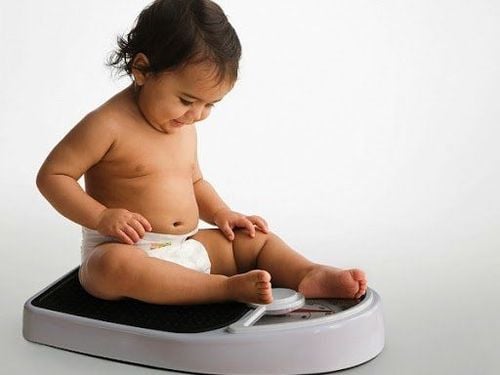This is an automatically translated article.
When caring for a baby from infancy, most parents tend to judge the baby's health through the process of excreting feces and urine. However, at each stage, your baby's poop will not be the same and will vary from baby to baby. So what is the normal condition of the child's stool?
1. Baby stool characteristics
1.1. Frequency of bowel movements Each individual child, corresponding to each stage of development and different nutrition, will have a different number of bowel movements per day. Breastfed babies often have more frequent bowel movements than formula-fed babies. The normal frequency of bowel movements in young children ranges from 7 times a day to once every 7 days, provided the child's stools are still soft and painless.
1.2. The amount of stools in infants Similar to frequency, the amount of stools of infants and young children each time they have a bowel movement is also very different. Newborns a few days old have stools that are proportional to the amount of milk they take in. However, many mothers are still worried because despite adding a lot of milk, the number of stools of the child is not adequate, at this time parents only need to care about the growth rate of their children. If the baby is still growing well, has no problems and the belly does not grow too much after breastfeeding, the baby's bowel problems will still happen normally.
1.3. Color of the baby's stool Newborns a few days old mainly pass meconium, which is black, thick, sticky and is produced when the baby absorbs nutrients while in the mother's womb. After the first stage, the baby's poop turns different colors like green, dark brown or yellow. Some unusual stool colors parents should be aware of are red, black and gray-white stools and need to take the baby to see a doctor immediately. During the development process, the color of the baby's stool will change differently for each stage, such as the color of the stool of a weaned baby will be different from that of an exclusively breastfed baby.
1.4. The texture of the baby's stool At the first stage of meconium, the stool of a newborn has a certain consistency. After that, the stool texture of exclusively breastfed babies is usually softer than formula-fed babies. Some babies' stools may have small particles, but this is completely normal and is essentially fat that is not fully digested. The texture of a baby's poop will change with age, as a 1-year-old's poop can be nearly identical to an adult's and completely different from an infant's.
If the texture of the baby's stool is loose and watery, it suggests that the baby is not well absorbed. The appearance of mucus is a sign of an intestinal infection and your baby needs to see a doctor for prompt treatment. In addition, constipation is a common digestive disorder characterized by very hard stools and painful bowel movements.
1.5. What does infant poop smell like? Newborn babies' stools in the first few days have very little odor, but after a while, the baby's intestines begin to form a bacterial system, gradually the infant's stools will become more foul.

Phân của trẻ sơ sinh có một số đặc điểm riêng biệt
1.6. Baby's facial expressions when having a bowel movement Most newborns have no symptoms or a slight grimace/red face during defecation. However, when children cry loudly every time they have a bowel movement, it is very likely that the baby is in pain, if this situation continues, parents need to take the child to see a doctor.
2. Compare stools of breastfed babies with formula-fed babies
2.1. Fecal characteristics of breastfed babies Under normal conditions, the stage of baby's meconium poop lasts only the first few days when the baby sucks colostrum because this type of milk has the effect of eliminating meconium from the child's body. After that, the stools of exclusively breastfed babies will gradually turn yellow and no longer have a strong smell. In addition, the texture of breastfed babies' stools is usually softer and more liquid than the viscous, sticky nature of meconium. Some children have slightly lumpy stools, but this is not too serious.
Especially, as mentioned above, breastfed babies often go to the toilet many times a day and make it harder for parents to take care of the baby. As the baby grows older, the number of bowel movements gradually decreases due to the stable functioning of the digestive system. Parents can be completely assured if the breastfed baby's stool is soft, the baby's bowel movements are not too difficult, and the number of bowel movements is stable.
2.2. Characteristics of stools of formula-fed babies One thing that many parents worry about when sharing their experiences is that formula-fed or formula-fed babies will defecate with different characteristics than breastfed babies. mother milk. Parents need to understand this feature to monitor their health and take good care of their children, and should not be too alarmed when they see that their child's poop is different from that of another baby.
Infants and young children who use formula instead of breast milk have characteristics such as yellow-brown or light yellow stools, and stools often have a stronger odor than breastfed babies. In addition, the amount of stool of a formula-fed baby is also higher in each bowel movement.
One feature to note is that formula-fed babies are easily constipated, constipation is more common than breastfed babies, so parents must take care of their babies carefully, supplement nutrients, Choose the right type of milk for your child's age for optimal functioning of the digestive system.
2. Characteristics of stools of weaning children
During the transition to a weaning diet combined with breast milk or formula, the color of the stools of the weaned baby changes markedly, most of which depends on the type of food the baby eats. For example, when eating carrots with carrots, the baby's poop will be bright orange.
Some characteristics of stools of children in the weaning stage:
When they start using solid foods, their stools tend to be harder and have a stronger smell. Children's stools at this stage may have some food inside. Some foods, such as raisins or whole beans, are difficult to absorb and may appear intact in the stool. The reason is that the baby's digestive system is still immature, not able to process all foods rich in fiber. Babies who eat a variety of foods often have thicker, darker, and stronger-smelling stools.

Chuyển sang giai đoạn ăn dặm thì phân của trẻ có phần khác biệt hơn
4. Some cases of abnormal stools of children that parents need to pay attention to
Cases of baby's stools that change when babies change their nutrition such as from breast milk to formula milk, the period of starting solid foods ... are completely normal. Parents do not need to worry too much about this issue. However, if the child's stool has the following characteristics, parents need to pay special attention:
4.1. Green baby poop The green color of the stools of babies and children can be caused by the baby absorbing too much lactose in milk. In this case, the mother can simply solve it by letting her baby focus on sucking all of the milk from one breast and then moving on to the other. In some cases, the baby's stool is green, suggesting that the baby is having some digestive problem:
The baby is being fed with formula milk, it may be because the baby is not suitable for the current product. Therefore, parents should learn and change to another more suitable product. Green stools can be a side effect of certain medications. Your baby's body is reacting to certain foods. In cases where the child's stool is green, parents should quickly take their child to see a doctor to determine the cause and handle it promptly.
4.2. Light colored baby poop Light colored baby poop suggests a rather serious condition. This sign could be a very dangerous neonatal jaundice. Therefore, parents need to observe their children more closely to detect jaundice early and see a doctor promptly. Usually jaundice goes away on its own after a while, but in some cases it can be severe and leave many serious consequences.
4.3. Bloody stools in children's stools bloody stools can be the result of prolonged constipation, making it difficult for children to pass and leading to anal fissures. Constipation is a disease that makes babies very tired and dehydrated, so they need to increase their water intake by drinking more breast milk. However, if the child's stool is mixed with blood and mucus along with other unusual signs, parents should take the child to see a doctor immediately.
4.4. Baby poop Raw poop is a phenomenon where the baby's stool contains food that has not been fully digested. Raw poop is uncommon in infants because the baby's main food source is milk. However, babies entering the weaning stage begin to be able to pass stools with food in them.
Passing raw poop is also cause for concern for parents but the good news is that this condition is benign, nothing dangerous. This is explained by the fact that babies who are just learning to eat solid foods and toddlers, have a lot of bowel movements while the food in the intestines has not yet been fully digested. This leads to the child's stool containing food.
However, in some cases, the baby's stools are raw, a sign of a serious illness. In particular, common diseases such as irritable bowel syndrome, food intolerances, allergies, bacterial infections and celiac disease can all cause raw stools in children.
In order to limit the child's constipation, parents should pay attention to the nutrition that improves the child's resistance. At the same time, add supporting foods containing lysine, essential micro-minerals and vitamins such as zinc, chromium, selenium, B vitamins,... snacks and less digestive problems.
Parents can learn more:
Why do you need to supplement Lysine for your baby?
The role of zinc - Guidelines for reasonable zinc supplementation
Please visit the website Vinmec.com regularly and update useful information to take care of your baby and family.













